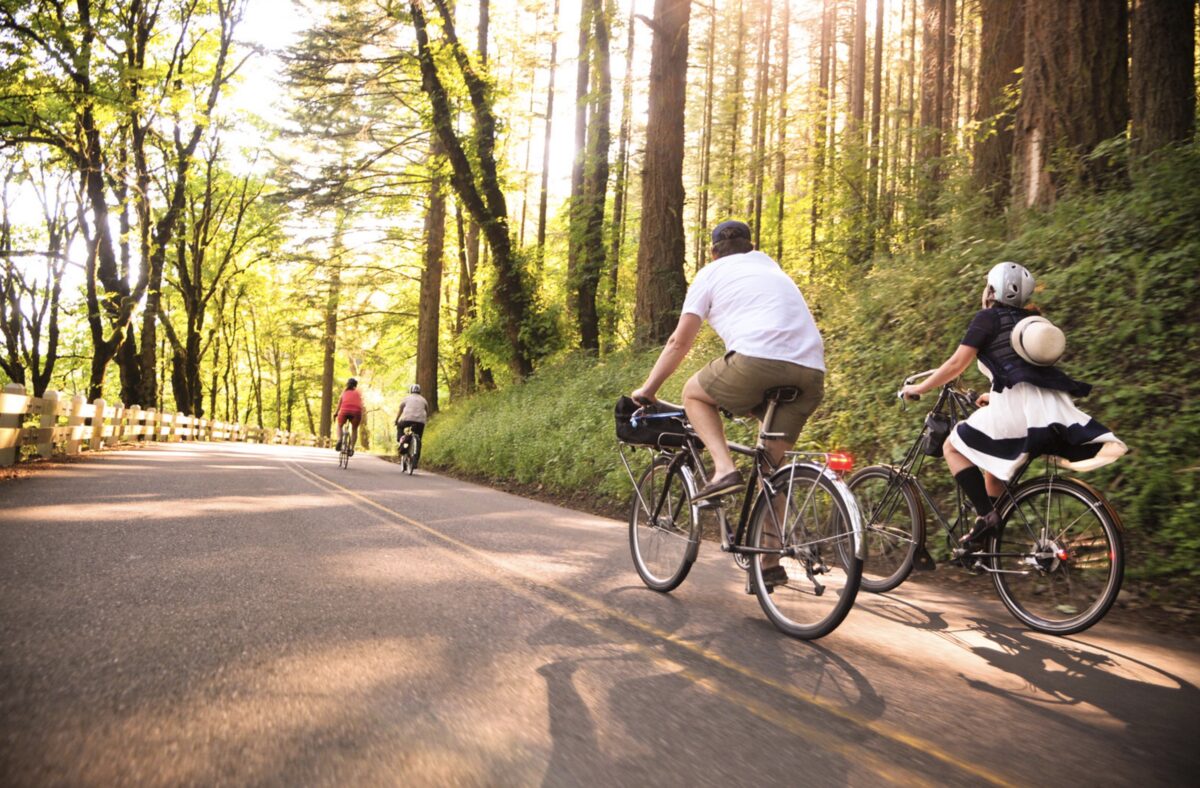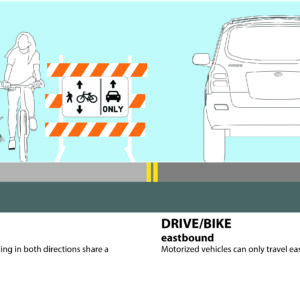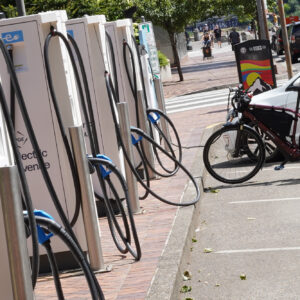
(Photo: Jonathan Maus/BikePortland)
“These flourishing conditions are sobering when we consider how little it takes to alter the ecosystem — the presence of even a few hundred more cars per day drastically changes this area.”
— Paul Pastor
It has now been over three months since the State of Oregon closed about 14 miles of the Historic Columbia River Highway in an effort to prevent the spread of COVID-19. The closure from Larch Mountain Road in Corbett to Ainsworth State Park has been a bummer for bike riders and other people who want to access one of the most beautiful roads in America.
But the animals are loving it.
Bridal Veil resident and writer Paul Pastor has seen with his own eyes and ears what’s possible in the Gorge when we remove the daily assault of thousands of cars and trucks. I came across a letter from Pastor written as a public comment in advance of an upcoming meeting of the Historic Columbia River Highway Advisory Committee. For anyone who’s dreamed of having fewer cars on the Historic Highway, his thoughts are worth a read:
“The unique conditions caused by the road closure of the Historic Columbia River Highway due to COVID-19 have created a powerful reminder of the impact of traffic on the delicate and rich environment here. The massive reduction of noise, light, and air pollution from cars has allowed residents along this corridor to see what ‘normal’ conditions would be in the absence of heavy, persistent, and invasive motor vehicle traffic. The difference is notable and unforgettable.
Advertisement
We have seen a healthy profusion of deer, elk, and coyote, and even signs of one lone (and shy) cougar. We’ve also noted a remarkable abundance of local and migratory birds, including several species that we (dedicated birdwatchers) have never observed here before. Apex predators like osprey, bald eagles, red-tailed hawks, and several species of owls are thriving.
These flourishing conditions are sobering when we consider how little it takes to alter the ecosystem — the presence of even a few hundred more cars per day drastically changes this area, let alone the overwhelming flow of traffic on peak days. While access to the waterfall corridor is vital to maintain and encourage, we residents of Waterfall Alley continue to ask for measures to be taken to reduce the human impact on this fragile and pristine environment in coming years. All measures to educate the public on lower impact recreation matter–especially when it comes to reducing traffic, encouraging “digital leave no trace” practices to reduce social media mobbing of popular tourist sites and trails, and other ways to mitigate our inevitable human impact on this special place.
As conversations continue about the future of this corridor, let’s remember the Spring of 2020 as a unique insight into what this place can be if we learn to tread more lightly on it. It’s beautiful.”

Speaking of those “conversations,” it’s been two years since we reported on ODOT’s plans to create a carfree lane on the Historic Highway to help reduce congestion, improve safety, and to improve access for bicycle riders and walkers. The exciting idea emerged from a year-long, $400,000 effort that culminated in the Congestion & Transportation Safety Improvement Plan. The initial thought was to try this out as party of a “phased re-opening” of the highway following closures from the Eagle Creek Fire.
Unfortunately, rockslides delayed the re-opening and then it seems like ODOT got cold feet (and/or a cold shoulder from agency leaders) and never pulled the trigger.
With another closure on our hands thanks to COVID-19, there might be another opportunity to do something bold.
At their meeting in May, committee member Kathy Fitzpatrick said (according to meeting minutes):
“Now, during the COVID-19 disruption of the status quo, is the ideal time to implement these types of pilot projects… The consequence of doing nothing now could result in the post-COVID carmageddon that transportation professionals are warning us about. Any reopening phases of the waterfall corridor need to move us closer to our stated goals, not further away.”
The committee meets again on Monday (7/13) and a discussion of the congestion mitigation plan is on the agenda. Stay tuned.
— Jonathan Maus: (503) 706-8804, @jonathan_maus on Twitter and jonathan@bikeportland.org
— Get our headlines delivered to your inbox.
— Support this independent community media outlet with a one-time contribution or monthly subscription.





Thanks for reading.
BikePortland has served this community with independent community journalism since 2005. We rely on subscriptions from readers like you to survive. Your financial support is vital in keeping this valuable resource alive and well.
Please subscribe today to strengthen and expand our work.
I highly encourage public testimony at Monday’s HCRH Advisory Committee meeting. I’ve been participating in these quarterly meetings for a few years and there is deep yearning by the committee to do a shuttle/bike/walk only OR 1-way vehicles, and the political will is *almost* there.
Forest Service, Parks and ODOT need to hear from naturalists, walking and biking visitors, with one unified message: open the highway to people and public transit and restrict vehicles, tour buses and able-bodied parking.
Monday, 7/13, 1-3p. Zoom link
Thanks for posting this link and for your comments in the meeting! I’m newish to the area, so I’m listening for now.
This headline kind of sums it all up. To take it to the logical conclusions, ” Stop the cars and heal the earth.”
Stop human activities if you really want to heal the earth.
Stop Civilization. Humans can be OK.
I’d rather all the muggle tourons congregate in this area than disperse out to the quieter places I go to avoid them 🙂
This might be true for some sections of the old highway, but many are so close to I-84 that I don’t think we would see a huge difference in air pollution, wildlife, etc.
That said, because of the proximity to I-84, most of the highway should be closed to cars. Maybe we can make a deal with local residents: don’t harass pedestrians and cyclists while you drive, and we’ll keep the tourists in cars away?
The Gorge photo made me ‘homesick’ for CycleWild bike touring trips of many summer’s past…as I eat my PB&J lunch at my desk…
you too can heal, Todd. Just get on the next plane from Hawaii to PDX and come join us!
It would be my dream to see a contraflow multiuse path on this road.
Motor vehicle levels in summer are horrific. The idea that this is supposed to be a scenic bike route is farcical when traffic is backed up waiting to park at Multnomah Falls for a mile all the way back to Bridal Veil, with no means to circumnavigate it due to the lack of shoulder or bikelane.
It’s time to do what places like the Grand Canyon have done, and remove auto traffic.
It gets a little tedious approaching Multnomah Falls on the weekend afternoons of high summer, but since those cars passed the bicyclist a little further back, bicyclists should feel no guilt in passing the line of stopped cars to get to Multnomah Falls. Share the road works both ways, cars pass us ALL THE TIME across the double yellows.
let’s just see how well they patch the holes from the aborted guard rail install!!!!?!
I work as a planner in the Gorge, LOVE riding the HCRH. Realistically, this is going to be an uphill battle but I hope it happens, there’s historic precedent to have the road open both ways and i suspect the motoring group – that was able to get cars included in the opening day festivities on the new stretch of TRAIL east of Cascade Locks – would raise a high stink if ODOT went ahead with one way traffic. I mentioned my personal interest in closing the HCRH down to motor traffic altogether to someone who reviews historic resources, and he countered that, since the highway was built for cars, there might be an argument to always keep it open to motor vehicles.
Lots of railroad miles were historically built for trains, but now serve other purposes. Why is what it was built for relevant? For that matter, isn’t it easier to preserve something when it only has to support lighter modes of use?
Because historically important resources in the Columbia River Gorge National Scenic Area are protected resources under each county’s adopted zoning regs that reflect the CRGNSA Management plan. The CRGNSA makes the HCRH ‘different’ from run of the mill rails to trails conversions and even roads in national parks.
I don’t know how it would play out if a proposal was ever initiated to close the road to private automobiles, but the use of the highway by cars is a historic component of the HCRH.
A lot of people seem to believe that if something was originally done for x reason, then any current-day use of that thing mean’s it’s still being done for x reason. As you point out, this is a completely faulty line of thinking.
Ah, but protecting historic and cultural resources (and the natural, scenic, and recreational resources) is written into the gorge management plan and codified by each of the six counties with CRGNSA lands. I’m for closing it to private motor vehicles, just not confident that’s a possibility with the CRGNSA overlay.
The canyon road in Zion NP was also “built for cars”. That doesn’t mean it is the best way to manage the resource. A eastbound-only HCRH would have many benefits. Because people wouldn’t be able to backtrack to popular sites, it would actually reduce the traffic. If the parking lot is not open, you have to continue east to another spot. I-84 is in close proximity for westbound travel. Most parking lots are on the south side of the highway, so converting the westbound highway lane into a MUP will minimize conflicts.
This would be the first step. If traffic levels continue to be a problem, the eastbound lane would become shuttle bus only, similar to the canyon road in Zion NP.
I’m a huge fan of the idea of closing it to all cars and having a shuttle service, maybe starting at the outlet mall parking lot in Troutdale? Turn the parking lots into picnic areas, keep a couple handicapped spots at each waterfall (with many at multnomah), and only allow local vehicles and disabled drivers on the road. There would be less incentive to drive if you can’t park anywhere in the area.
You could also use Crown point as a turnaround spot and checkpoint, I’d be willing to pay a couple bucks each time through on my bike if it paid for a gate and tollbooth, and the benefit was a stress free ride through the gorge, without the eyesore of lines of cars backed up at each waterfall. You could even just operate it during high season, and have it fully open during the fall and winter months.
It seems most of the hikes *could* be accessed from I-84, if a few pedestrian bridges over the railroad tracks were built. Latourell Falls & Vista House could be accessed from Rooster Rock. Wahkeena falls is directly adjacent to Benson State Park. That might help reduce traffic on the road if nothing else. Though ideally the road could then be given over to bikes, shared ebikes (just imagine! they could charge while you took a hike, I know, not going to happen), and maybe a bus system.
As an avid hiker/backpacker, I cannot support most proposals I’ve seen here that would close the HCRH fully to cars due to problems with trailhead access. But I really like this specific proposal if the funds can be found because it creates the best of both worlds: a carfree HCRH for cyclists and runners to enjoy, while at the same time preserving access for hikers to all the amazing trails in the area.
West of Angels Rest there are private residences, so it would be impossible to close the road fully. But east of that it should be quite easy. The four important destinations are Wahkeena Falls, Multnomah Falls, Horsetail Falls, and Ainsworth State Park. Multnomah already has access from I-84, and keeping HCRH auto access for only a very small portion of the east end can preserve access to Ainsworth. As you mention, a bridge or tunnel from Benson can provide access to Wahkeena. This only leaves Horsetail as requiring significant investment to create access from I-84.
There are at least 10 residences/properties between Angels Rest and Multnomah Falls. Maybe another 30 or so from Angels Rest westward to Larch Mountain Rd. There will have to be car access through these areas, and making it eastbound only will be tough since some families send kids westward to Corbett for school. But maybe some sort of compromise could be worked out
Thanks, I was unaware that there were also residences east of Angels Rest. Perhaps the carfree section could be started after the residences, but before Wahkeena. That would still remove all the recreation traffic, while maintaining access.
The most realistic solution is probably to keep the road open but close all the parking. And probably just weekends in the summer. Trail access would be from I-84 as described above, except for those who take a bus or can get dropped off. That would get rid of 80% of the traffic.
To assume it’s only vehicles causing this is missing the mark. Humans are the problem. The gorge suffers from Portland being so close… I mean, they dammed up the Columbia for people reasons… that has had profound impacts on the whale and salmon populations. Humans pack the gorge and litter like crazy, start illegal fires, and somehow bag their dog feces and then leave it along the trail. They enter closed areas routinely and with ease. I think what we should really talk about is limited entry. I’m down with a bike lane, especially in the busy months when it could be utilized and even a parking lot, yep, so that people from outside of Portland can still utilize the path and not cause more congestion.
Wow, you can’t even bike or walk on the historic highway right now!? What are they gonna do, arrest you? Seems like a good way to social distance.